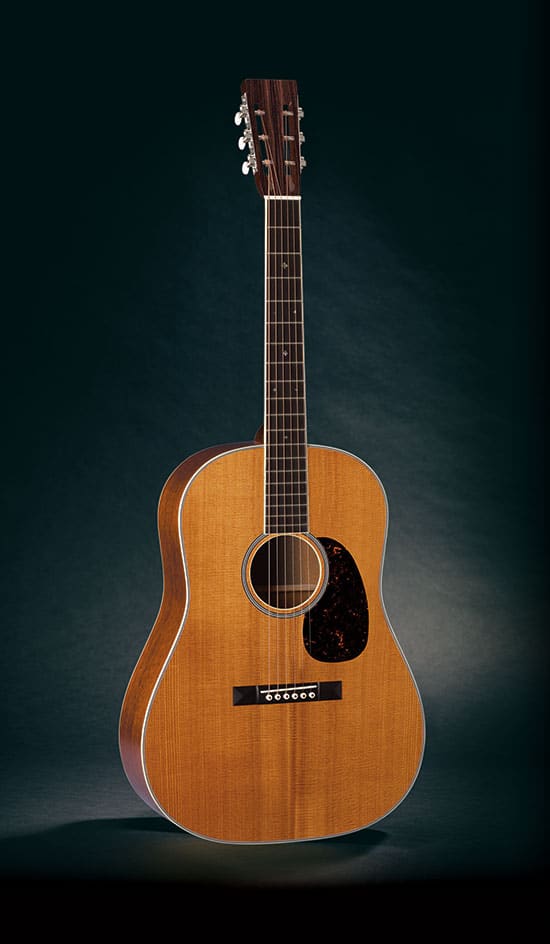
The C.F. Martin Company has been building guitars in America since the 1830s, but it wasn’t until 100 years ago that the company first made the body style it is perhaps most closely identified with: the Dreadnought. Originally manufactured in 1916 expressly for the Ditson retail stores in Boston and New York, Martin’s Dreadnoughts didn’t actually have the Martin name on them for the first several years. Martin provided Ditson with Dreadnoughts, and other stringed instruments, until 1930. These larger-bodied guitars – under the monikers D-28, D-18 and so on (“D” stands for Dreadnought) – started to catch on, and began to play a major role in the evolution of acoustic American music, and in the evolution of Martin itself.
Martin’s Dreadnought (spelled “Dreadnaught” in the company’s old catalogs) was used by players of country and old-timey music before becoming a staple of bluegrass when that art form was born in 1945. In the days before decent amplification, this larger guitar allowed its players to compete with the volume of other instruments. Since those days, the “D” has become a favorite of rock, blues, Americana and even a few jazz performers. Indeed, it has helped define the music of players who have become known as virtuosos and songwriting legends. A comprehensive list of players who have used Martin Dreadnoughts would be nearly impossible to compile. Alternative innovator Beck; Elvis Presley; new age pioneer Michael Hedges; jazz great Gabor Szabo; newgrass innovator Tony Rice; bluegrass legend Clarence White; singer-songwriter Joni Mitchell; country star Dierks Bentley; bluesman Brownie Terry; Union Station’s Dan Tyminski … it goes on and on. From Hollywood cowboy Gene Autry (the first D-45) and “Queen of Country” Kitty Wells, to 21st century players like Seth Avett and the Punch Brothers’ Chris Eldridge, popular stars and instrumental legends have built careers using Martin Dreadnoughts.
Numerous other guitar companies have since manufactured their own Dreads, as the designation refers to a body style and size and not a trademarked name per se. So what actually determines whether or not a guitar can be called a Dreadnought? We posed the question to George Gruhn, an expert on Martins who has sold thousands of these guitars to some of the world’s leading players at his Nashville store, Gruhn Guitars, in the past 46 years. “It’s the basic size and shape,” says Gruhn. “But especially the shape. When people think of the Dreadnought today, they’re generally thinking of the square-shouldered guitar that Martin introduced early in ’34, no matter who the manufacturer actually is.”
Del McCoury is one of the elder statesman of bluegrass, and an inspiration for today’s young bluegrassers as well as many Americana performers. His career began over half a century ago, and he played for several years with the Father of Bluegrass himself, Bill Monroe. Through it all, McCoury has primarily played a Martin D-28 while collaborating with everyone from Steve Earle to the Preservation Hall Jazz Band. Martin built its DM-28 model especially with McCoury in mind.
“I had played a 1952 D-28 before I joined Bill Monroe,” McCoury recalls, looking back over his long career. ”I’ve played Martin guitars since I can remember. The one I played mostly until recently is a 1956 D-28. When I was with Bill I was playing his guitar, actually – it was a 1939 D-28, a herringbone. It was played by everybody before me from Lester Flatt on down. I left Bill in 1964, and I think it was sometime in ‘65 or ’66 that somebody stole it from him. And to my knowledge nobody has seen or heard of it since.”
“When I turned 75 Martin gave me an Authentic Series reproduction of a 1939 D-28, and I play that one a lot today,” McCoury continues. “I had it for a while before I tried it. I frankly didn’t have a lot of faith in it because it was new. But a few months ago I put new strings on it, strummed on it, and I thought, man, this thing sounds good! I’m in a band with banjo and mandolin, so it’s got to be able to cut, and it does. I’ve been playing it a lot ever since.”
Martin Chairman and CEO Christian Frederick “Chris” Martin IV comes from a long line of directors of the family business. The company has been handed down six times since it was started by German immigrant Christian Frederick Martin Sr., Chris Martin’s great-great-grandfather, in 1833. Chris explains that the guitar was named “Dreadnought” because of its size, in reference to the enormous British Royal Navy warship of the same name. “2016 isn’t just the 100th anniversary of the Dreadnought guitar, it’s also the 110th anniversary of the HMS Dreadnought ship,” Martin says. “The guitar was named after the ship by my grandfather (C. F. Martin III), who was an amateur historian, because he saw a connection between the biggest battleship ever made and the biggest Martin guitar ever made.”
Chris says he doesn’t consider himself much of a guitarist, but he knows a thing or two about how a Dread is supposed to be played, having grown up listening to Dreadnought players like Stephen Stills in the 1970s. “What I appreciate about the Dreadnought is its presence,” he says. “I think that’s the reason it became so popular. It’s imposing, but stylistically rather austere. And it’s loud, but it’s more than just loud. It’s got a look about it that says, like, no kidding, no foolin’ around, you’re gonna hear some good music from this guitar. And it’s not really a couch guitar; if you want to sit on the couch and noodle that’s fine, but if you’re gonna stand up and play in front of a packed house, nothing beats a Dreadnought.”
Mac Powell is the front man for Third Day, the groundbreaking Grammy-winning Christian rock band, and has also recorded two country albums. The left-handed Powell is a Martin Ambassador and a Dreadnought player, playing a D-28 and a pair of D-35s, one being a Johnny Cash Commemorative with a polished black finish.
“I’d always really loved Martins, and after about 15 years of playing other guitars I finally realized that the Martin Dreadnought really felt right, really sounded right,” Powell says. “My approach is more of a folk style, a singer-songwriter style, and that fuller sound from that bigger guitar is what I love. And it’s not just that they’re louder, but the ones I’m playing are beautiful and amazing-sounding guitars. They’re very versatile and just fit my style. Third Day’s music and my own country stuff are, to me, very American-sounding music, and the Martin Dreadnought is an American staple. It’s great to have a guitar in my hands that I’m able to play and say, ‘This is it.’”
It’s incredibly rare for any company to have survived for more than 180 years, much less to be able to claim that one of its products helped shape a culture, and is still being sold a century later. But such is the case with Martin and the Dreadnought. “I’m really honored to have one named for me,” McCoury says, “and to be able to play a Martin guitar.”
